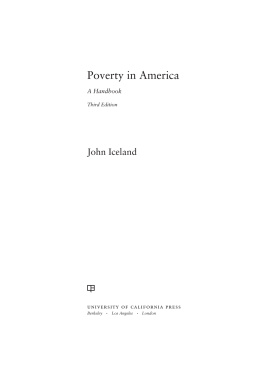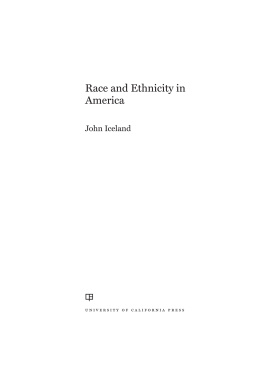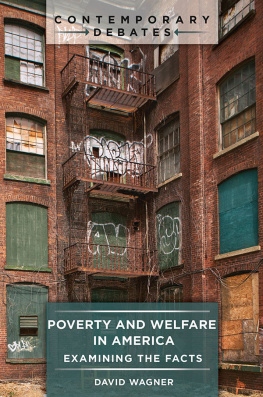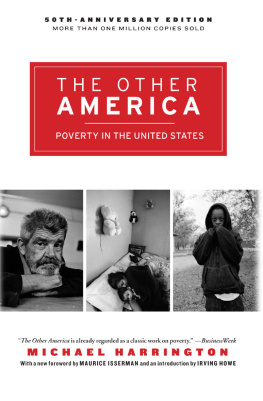Iceland - Poverty in America: a handbook
Here you can read online Iceland - Poverty in America: a handbook full text of the book (entire story) in english for free. Download pdf and epub, get meaning, cover and reviews about this ebook. City: Berkeley, year: 2013, publisher: University of California Press, genre: Politics. Description of the work, (preface) as well as reviews are available. Best literature library LitArk.com created for fans of good reading and offers a wide selection of genres:
Romance novel
Science fiction
Adventure
Detective
Science
History
Home and family
Prose
Art
Politics
Computer
Non-fiction
Religion
Business
Children
Humor
Choose a favorite category and find really read worthwhile books. Enjoy immersion in the world of imagination, feel the emotions of the characters or learn something new for yourself, make an fascinating discovery.
Poverty in America: a handbook: summary, description and annotation
We offer to read an annotation, description, summary or preface (depends on what the author of the book "Poverty in America: a handbook" wrote himself). If you haven't found the necessary information about the book — write in the comments, we will try to find it.
Iceland: author's other books
Who wrote Poverty in America: a handbook? Find out the surname, the name of the author of the book and a list of all author's works by series.
Poverty in America: a handbook — read online for free the complete book (whole text) full work
Below is the text of the book, divided by pages. System saving the place of the last page read, allows you to conveniently read the book "Poverty in America: a handbook" online for free, without having to search again every time where you left off. Put a bookmark, and you can go to the page where you finished reading at any time.
Font size:
Interval:
Bookmark:

Poverty in America
Poverty in America
A Handbook
Third Edition
John Iceland

UNIVERSITY OF CALIFORNIA PRESS
BerkeleyLos AngelesCalifornia
University of California Press, one of the most distinguished university presses in the United States, enriches lives around the world by advancing scholarship in the humanities, social sciences, and natural sciences. Its activities are supported by the UC Press Foundation and by philanthropic contributions from individuals and institutions. For more information, visit www.ucpress.edu.
University of California Press
Berkeley and Los Angeles, California
University of California Press, Ltd.
London, England
2013 by The Regents of the University of California
Library of Congress Cataloging-in-Publication Data
Iceland, John.
Poverty in America : a handbook / John Iceland. 3rd ed.
p. cm.
Includes bibliographical references and index.
ISBN 978-0-520-27636-9 (pbk., alk. paper)
eISBN 978-0-520-95679-7
1. PoorUnited StatesHistory. 2. PovertyUnited StatesHistory. 3. Economic assistance, DomesticUnited StatesHistory. I. Title.
HC110.P6I252013
339.460973dc232012042288
Manufactured in the United States of America
22 21 20 19 18 17 16 15 14 13
10 9 8 7 6 5 4 3 2 1
In keeping with its commitment to support environmentally responsible and sustainable printing practices, UC Press has printed this book on Cascades Enviro 100, a 100% post consumer waste, recycled, de-inked fiber. FSC recycled certified and processed chlorine free. It is acid free, Ecologo certified, and manufactured by BioGas energy.
To Mia, Jakob, and Jeannie
Contents
Illustrations
FIGURES
TABLES
Preface
Much has changed since I wrote the second edition of Poverty in America. The Great Recession and its aftermath have brought new attention to the problems of poverty and inequality. My goal here is to provide a fresh look at patterns and trends in poverty and help contextualize them. This is necessary for providing a basis for an honest political discussion of what ails us and what we can do about it. That is not to say that information alone leads to specific policy solutions. Policy is always guided in part by peoples values. But having a better understanding of a problem is necessary for more wisely choosing a course of action that will ultimately help further ones goals.
This edition contains numerous changes from the previous one. First, this edition contains two new chapters. Chapter 4 discusses global poverty, and chapter 6 tackles the Great Recession. There was a limited discussion of poverty in the international context in the previous edition, but I opted for a fuller treatment here. There is much we can learn about poverty in the United States by comparing our experience with those of other nations. The new chapter on the Great Recession discusses both its causes and effects on American society. Although the recession officially ended in 2009, its impact on both the U.S. economy and its politics has been far reaching. One empirical chapter was eliminated from this edition, chapter 6 in the previous edition, Why Poverty Remains High, Revisited; the information in this chapter, although originally useful, became increasingly dated.
Second, in addition to adding and subtracting these chapters, I updated other ones so that they engage in extended discussions of recent poverty debates. I discuss, for example, how the recession helped spawn the Tea Party and Occupy Wall Street movements. The chapter on the causes of poverty delves into the debate about whether culture or changing economic conditions are more responsible for increases in female headship and nonmarital fertility, especially among the white population, in recent years. The chapter on policy discusses the contrasting visions of governments role in society that permeate current policy debates, including the debate on President Obamas Patient Protection and Affordable Care Act, or Obamacare.
I sought to make this edition more accessible for students of poverty by adding vignettes throughout the book to illustrate theoretical arguments and statistical findings. For example, I discuss newspaper accounts of Apples Foxconn factories in China to illustrate why many U.S. manufacturing jobs have gone overseas as well as the difficult working conditions faced by many people in developing countries. I provide short accounts of the psychological toll of losing a job during the recession and stories of the hardships experienced by people who are desperately poor. This helps humanize poverty for people with relatively little firsthand knowledge of what it means to be poor.
Finally, I updated all of the tables and figures in this edition so that they contain the latest information available. This involved eliminating some tables and figures and adding new ones. Naturally, the text accompanying these tables and figures was likewise updated.
In short, the second edition of Poverty in America was beginning to show its age. This edition provides basic updates to facts and figures, but, more importantly, it engages in the most recent research and current political debates on poverty. In the wake of the deepest recession since the Great Depression, the time is ripe for a renewed discussion of poverty in America.
Acknowledgments
I would like to thank a number of people who helped in the development of this book, including its earlier editions: Gordon Fisher, Patricia Ruggles, Daniel T. Lichter, Andrew Beveridge, Josh Kim, Susan Ferber, Leif Jensen, and Charles Ferrer. A special thanks to Naomi Schneider at the University of California Press, who has provided invaluable advice, direction, and support for this project over the years. My thanks as well to Mari Coates and Stacy Eisenstark at the University of California Press for their dedicated work.
I have the deepest gratitude for my friends and family for their support and encouragement, including my wife, Jean, who inspired me to write this book and is always there for me. I would like to thank my children, Jakob and Mia, for the light they bring into our lives; and my parents, Harry and Joan, for all they have done and continue to do. Finally, I would like to thank all of my other family members, including Charles, Debbie, Matthew, Josh, Matt, John, and Edna.
Introduction
Poverty will always be with us. This is not a new idea. From the Gospel of John to today many have despaired that poverty is an enduring feature of society, even as they search for ways to alleviate it. But is this true? Will poverty really always be with us?
The last fifty years, much like the fifty years before it, have been an economic roller coaster. In 1964 President Lyndon Johnson boldly proclaimed the War on Poverty, making it the centerpiece of his domestic agenda. Then, after nearly a decade of true progress against poverty in the United Statesthe poverty rate declined from 19 percent in 1964 to 11 percent in 1973progress stalled. The 1970s and early 1980s saw two recessions and a simultaneous bout of high inflation and unemployment. This led Ronald Reagan to quip, in 1988, My friends, some years ago the federal government declared war on povertyand poverty won. Nevertheless, the good economic times were hardly over for good. The 1990s were generally a decade of very healthy economic growth during which both high- and low-income Americans experienced increases in their standards of living. In 2000, President Clintons Council of Economic Advisors predicted the dawn of a new era in which the business cycle of boom and busts would soon be but a memory. Unfortunately, a mere decade laterafter another two recessions, including the near economic catastrophe of the Great Recession of 20079the economic and political mood of the country seemed to reach a new low. There was a feeling that Americas best days were in the past, and it was only a matter of time before other countriesespecially Chinawould take the mantle as the new global superpower.
Next pageFont size:
Interval:
Bookmark:
Similar books «Poverty in America: a handbook»
Look at similar books to Poverty in America: a handbook. We have selected literature similar in name and meaning in the hope of providing readers with more options to find new, interesting, not yet read works.
Discussion, reviews of the book Poverty in America: a handbook and just readers' own opinions. Leave your comments, write what you think about the work, its meaning or the main characters. Specify what exactly you liked and what you didn't like, and why you think so.












